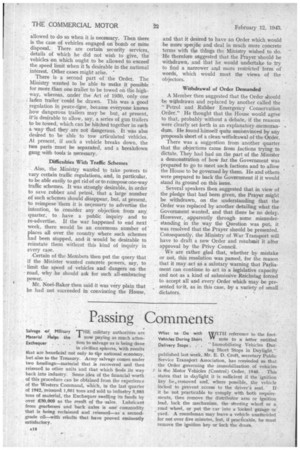Passing Comments
Page 18

Page 19

If you've noticed an error in this article please click here to report it so we can fix it.
THE military authorities are
now paying as much attention to salvage as is being done in civilian spheres, with results that are beneficial not only to -the national economy. but also to the Treasury. Army salvage comes under two headings—material that is recovered and then reissued to other units and that which finds its way back into industry. Some idea of the financial worth of this procedure can be obtained from the experience of the Western Command, which, in the last quarter of 1942, reissued 1,661 tons and sold to industry 5,085 tons of material, the Exchequer swelljng its funds by over E30,000 as the result of the 'sales. Lubricant from gearboxes and back axles is one' commodity that is being reclaimed and reissued—as a secondgrade oil—with risults that have proved eminently satisfactory. Exchequer . . . WITH reference to the foot" note to a letter entitled "Immobilizing Vehicles Dur . ing Short Stops in Daylight," published last week, Mr. E. D. Croft, secretary Public Service Transport Association, has reminded us that the Order governing the immobilization of vehicles / is the Motor Vehicles (Control) Order, 1940_ This states that in daylight it is sufficient if the ignition key be „removed and, where possible, the vehicle kicked to prevent access to the driver's seat. If it be not practicable to comply with both requirements, then remove the distributor arm or ignition lead, lock the mechanism, the steering wheel or a road wheel, or put the car into a locked gnrage or yard. A roundsman. may leave a vehicle unattended for not over five minutes, but, if practicable, he must remove the ignition key or lock the doors.
Brave Act Results in A TRIBUTE to an act of Widow Receiving' 1-k heroism'on the part Gra. Carnegie Medal . . member of the motor rndustry,
Mr. Raymond W. Lea, is the award of the Hero Fund Medal to his widow by the Carnegie Trustees. His former ern'ployer, Mr. R. M. Papelian, had already instituted a fund, which totalled n1,960, and the income from this is being augmented by the Carnegie Fund. It will be remembered that Mr. Lea was killed while saving a woman who had stepped out of the wrong side!' of a train.
American Engineer's ACCORDING to R.U.P., the Views on Develop4Thvice-president of General ments with Cars . . Motors said recently that cars,
, after the war, will be designed in aluminium and newly developed plastics; Whilst, through the use of 110 octane petrol, the size of the engine would be reduced by two-thirds. Such a reduction appears to us to be out of the question. We could believe that, eventually, the reduction could be one-third. He also Stated that synthetic tyres would then last the life of the vehicle. Production of such types are expected in 1945-46. It will probably be a lot later before commercial vehicles in any considerable quantity become so thoroughly changed. * * Were Their Journeys WITH so many girls in the Really Necessary in ' vv Services or on war 'work, This Case there is often a shortage of the fair •sex at camp 'dances, consequently cavaliers scour the countryside beforehand to beg, borrow or steal partners. On one occasion recently a car was sent 30 miles (each way) to issue invitations, and, later, two Army lorries and a Brengun carrier made the same journey to collect the girls and return them to their billets—on Army petrol which, we have been assured, is now being economized."




























































